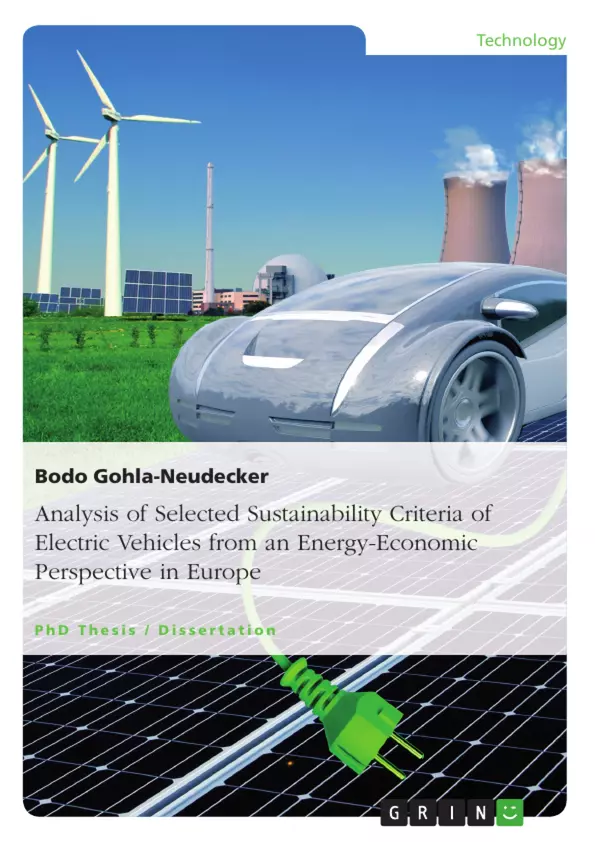Abstract
Within the scope of this dissertation, a model for synthesising the future development of EV power consumption is presented and incorporated in a European energy system model. Three allocation methodologies – the mix, delta and parallel market methods – are presented and allow a differentiated evaluation of selected sustainability criteria of EVs (well-to-wheel efficiencies, CO2 emissions and energy costs). These are compared to values of ICVs from 2015 to 2050 in 27 European countries. Results conclude that the sustainability advantages of EVs in Europe fully come to effect from 2025 onwards.
Zusammenfassung
Im Rahmen dieser Arbeit wird ein Modell für die Synthese des zukünftigen Stromverbrauchs von Elektrofahrzeugen vorgestellt und in einem europäischen Energiesystemmodell integriert. Drei Zuweisungsmethoden – die Mix-, Delta- und Parallelmarkt-Methode – ermöglichen eine differenzierte Bewertung von Elektrofahrzeugen (Primärenergieeffizienz, CO2-Emissionen und Energiekosten). Diese werden mit den Werten von konv. Kfz von 2015 bis 2050 in 27 europäischen Ländern verglichen. Die Ergebnisse zeigen, dass die Nachhaltigkeitsvorteile von Elektrofahrzeugen in Europa ab 2025 voll zum Tragen kommen.
Inhaltsverzeichnis (Table of Contents)
- Acknowledgements
- Abstract
- Zusammenfassung
- List of Figures
- List of Tables
- List of Abbreviations
- 1 Introduction
- 1.1 Motivation and Research Gap
- 1.2 Aims and Objectives
- 1.3 Scope and Structure of the Dissertation
- 2 Methodology and Model Description
- 2.1 Model Structure and Implementation
- 2.2 Sub-Models and their Integration
- 2.3 Model Input Data
- 2.4 Model Calibration and Validation
- 3 Sustainability Criteria for Electric Vehicles
- 3.1 Well-to-Wheel Efficiency and CO2 Emissions
- 3.2 Life Cycle Assessment of Battery Electric Vehicles
- 3.3 Energy Costs for Electric Vehicles
- 4 Energy Systems Model URBS-EU
- 4.1 Model Description and System Boundaries
- 4.2 Implementation of Electric Vehicles
- 4.3 Analysis of Energy System Developments
- 5 Application and Simulation Results
- 5.1 Analysis of Electricity Demand and Supply
- 5.2 Evaluation of Sustainability Criteria
- 5.3 Sensitivity Analysis and Scenario Variations
- 6 Discussion and Conclusion
- 6.1 Key Findings and Interpretations
- 6.2 Implications and Recommendations
- 6.3 Further Research Needs
- Bibliography
Zielsetzung und Themenschwerpunkte (Objectives and Key Themes)
This dissertation analyzes the sustainability of electric vehicles (EVs) from an energy-economic perspective in Europe. The study aims to evaluate selected sustainability criteria, including well-to-wheel efficiencies, CO2 emissions, and energy costs, for EVs compared to internal combustion vehicles (ICVs) from 2015 to 2050. The research integrates a model for EV power consumption into a European energy system model and employs three allocation methodologies: the mix, delta, and parallel market methods.- Sustainability of electric vehicles in Europe
- Comparison of EVs and ICVs
- Well-to-wheel efficiency and CO2 emissions
- Energy costs
- European energy system model integration
Zusammenfassung der Kapitel (Chapter Summaries)
- Chapter 1: Introduction: This chapter introduces the motivation for this study, highlighting the research gap regarding comprehensive analysis of EV sustainability in Europe. It defines the study's aims and objectives, outlining the scope and structure of the dissertation.
- Chapter 2: Methodology and Model Description: This chapter presents the model structure and implementation, explaining the sub-models and their integration within the European energy system model. The chapter also discusses model input data, calibration, and validation procedures.
- Chapter 3: Sustainability Criteria for Electric Vehicles: This chapter focuses on defining and analyzing the sustainability criteria relevant to EVs, including well-to-wheel efficiency, CO2 emissions, and life cycle assessments. Energy cost analysis is also explored.
- Chapter 4: Energy Systems Model URBS-EU: This chapter provides a detailed description of the URBS-EU energy system model, outlining its functionalities and system boundaries. The chapter explains the implementation of EVs into the model and explores the analysis of energy system developments under different scenarios.
- Chapter 5: Application and Simulation Results: This chapter presents the results of applying the URBS-EU model to assess the sustainability of EVs in Europe. It analyzes the impact of EV adoption on electricity demand and supply, evaluates the sustainability criteria across different regions and scenarios, and conducts sensitivity analyses.
Schlüsselwörter (Keywords)
Electric vehicles, sustainability, well-to-wheel efficiency, CO2 emissions, energy costs, European energy system, model, simulation, allocation methodologies, mix method, delta method, parallel market method, URBS-EU, sustainability criteria, life cycle assessment.- Arbeit zitieren
- Bodo Gohla-Neudecker (Autor:in), 2014, Analysis of Selected Sustainability Criteria of Electric Vehicles from an Energy-Economic Perspective in Europe, München, GRIN Verlag, https://www.grin.com/document/279160



